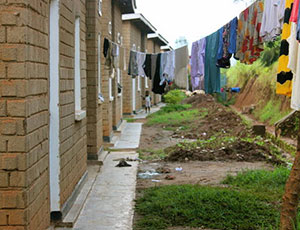(English) July 16, 2012

Many of the residents who were relocated from Kiyovu to Batsinda (pictured), complain they have lost income. Photo: Jean de la Croix Tabaro
The UN special rapporteur on adequate housing, Raquel Rolnik , has issued her preliminary findings on habitat in Rwanda, saying that implementation still faces challenges.
In the nine days she spent in the field, she worked on the policy of villagisation-imidugudu, the land reform policy and urban strategies, then on planning and housing in Kigali.
According to the researcher, the findings helped her to understand ongoing policy implementation and its impediments. “I visited the model umudugudu of Nyagatovu in the Eastern province, which clearly represents the government’s vision of what an umudugudu should be. The inhabitants indicate that their living conditions had significantly improved by moving to the new settlement,” Rolnik said.
The improved living conditions were the result of the fact that the people had been compensated upon relocation, and that new houses were made of modern and durable materials. They were provided with a latrine per family and basic infrastructure in the settlement.
Yet Rolnik pointed out that this is not the case in all imidugudu. “In another village I visited, residents indicated they had been forcefully moved and claim their living conditions had not really improved up to now because neither infrastructure nor any effort to improve their livelihoods was deployed.”
Rolnik commended the ‘Bye bye Nyakatsi’ policy launched in 2010, which aimed at replacing grass-thatched houses with shelters made of durable materials, via manpower provided by community work and some materials made available by the government. The policy, she reported, managed to make Nyakatsi history, yet one problem is that 2% of those affected are still lacking shelter.
“It left several homeless people, with a number of families still waiting to be rehoused,” she said. “It is of paramount importance to ensure that in the new location, displaced populations enjoy a standard of living that is at least equal, if not better, than the one they had before.”
Concerning the land reform policy, Rolnik said that it has the potential of improving the living conditions of people in planned and organized settlement. However, she stressed that the overall risk here would be exposing very small landholders (with 0.52 ha) to market pressure.
“I find it important for rural families to maintain a level of subsistence agriculture, as to meet their day-to-day needs, which is sometimes compromised by mono-crop farming,” she said. “The Government needs to make sure that implementation of the land consolidation policy is conducted on the basis of the human rights values of consultation and participation. Involvement in land consolidation projects must be voluntary and in no way based on coercion.”
Urban planning challenged
The researcher questions the legitimacy of relocation in Rwanda where she says that “many elements of the legal regime applicable to expropriations in Rwanda raise questions of conformity with international standards.”
She cited the example of Kiyovu and Kimicanga were people were expropriated to make place for private commercial developments, and said this can raise questions about the nature of the public interest involved. “Moreover, the sites which were cleared out remained mostly vacant, as there is much office space available in the newly built high-rises of central Kigali.”
Those expropriated were given the chance of accepting monetary compensation and moving to a place of their choice or to invest their compensation payment in a new house at Batsinda, Gasabo district, an area located some 15 km away from the area they had been moved from. “But they were paid insufficient money,” Rolnik said.
“It is very difficult for us to pay for this house,” confirmed a mother of 2 in Batsinda. “We are now living here because we have no other choice. They only gave us Frw 1m, which they put towards the house and we had to add more money to get the house we are living in now.”
The woman said she would have preferred receiving the money upfront and choosing where to live, but she claimed the compensation they got would not buy even a plot.
Life is hard in Batsinda, she said, and they lost a huge chunk of their income because of the government housing location in the sector. She used to sell food out of their house in Kiyovu. “My husband, a taxi driver, brought in some money and I brought in more, but now I just depend on my husband,” she said, adding that the placement of the houses in Batsinda, which are off the main road in a sunken area on a hill, makes it hard to do business.
Lilian Uwanziga Mupende, the director of urban planning and construction for the city acknowledges these difficulties have existed in past but that future plans will take into account location and proximity to the old areas. “The relocation of people goes beyond just housing, it is about how they adapt to the social and economic environment,” she said. “Batsinda was quite a success but one of the things that became evident was that changing the standard of living was quite an adjustment.”
Source: The Rwanda Focus

Deixe um comentário